

Compact Muon Solenoid
LHC, CERN
| CMS-HIG-18-007 ; CERN-EP-2018-221 | ||
| Search for the associated production of the Higgs boson and a vector boson in proton-proton collisions at $\sqrt{s} = $ 13 TeV via Higgs boson decays to $\tau$ leptons | ||
| CMS Collaboration | ||
| 10 September 2018 | ||
| JHEP 06 (2019) 093 | ||
| Abstract: A search for the standard model Higgs boson, decaying to a pair of $\tau$ leptons and produced in association with a W or a Z boson is performed. A data sample of proton-proton collisions collected at $\sqrt{s} = $ 13 TeV by the CMS experiment at the CERN LHC is used, corresponding to an integrated luminosity of 35.9 fb$^{-1}$. The signal strength is measured relative to the expectation for the standard model Higgs boson, yielding $\mu = $ 2.5$ ^{+1.4} _{-1.3}$. These results are combined with earlier CMS measurements targeting Higgs boson decays to a pair of $\tau$ leptons, performed with the same data set in the gluon fusion and vector boson fusion production modes. The combined signal strength is $\mu = $ 1.24$ ^{+0.29} _{-0.27}$ (1.00$ ^{+0.24} _{-0.23}$ expected), and the observed significance is 5.5 standard deviations (4.8 expected) for a Higgs boson mass of 125 GeV. | ||
| Links: e-print arXiv:1809.03590 [hep-ex] (PDF) ; CDS record ; inSPIRE record ; HepData record ; CADI line (restricted) ; | ||
| Figures | |

png pdf |
Figure 1:
The post-fit $ {m_{{\tau} {\tau}}} $ distributions used to extract the signal shown for (upper left) $\ell \ell {\mathrm {e}} {{\tau} _\mathrm {h}} $, (upper right) $\ell \ell {{\mu}} {{\tau} _\mathrm {h}} $, (lower left) $\ell \ell {{\tau} _\mathrm {h}} {{\tau} _\mathrm {h}} $, and (lower right) $\ell \ell {\mathrm {e}} {{\mu}}$. The uncertainties include both statistical and systematic components. The left half of each distribution is the low $ {L_{\text {T}}^{\text {Higgs}}} $ region, while the right half of each distribution is the high $ {L_{\text {T}}^{\text {Higgs}}} $ region. The WH and ZH, $ {{\mathrm {H}} \to {\tau} {\tau}} $ signal processes are summed together and shown as VH, $ {{\mathrm {H}} \to {\tau} {\tau}} $ with a best fit $\mu = $ 2.5. VH, $ {{\mathrm {H}} \to {\tau} {\tau}} $ is shown both as a stacked filled histogram and an open overlaid histogram. The contribution from "Other'' includes events from triboson, $ {{\mathrm {t}\overline {\mathrm {t}}}} + {\mathrm {W}}$/$ {\mathrm {Z}} $, $ {{\mathrm {t}\overline {\mathrm {t}}}} {\mathrm {H}} $ production, and all production modes leading to $ {{\mathrm {H}} \to {\mathrm {W}} {\mathrm {W}}} $ and $ {{\mathrm {H}} \to {\mathrm {Z}} {\mathrm {Z}}} $ decays. In these distributions the ZH, $ {{\mathrm {H}} \to {\tau} {\tau}} $ process contributes more than 99% of the total of VH, $ {{\mathrm {H}} \to {\tau} {\tau}} $. |
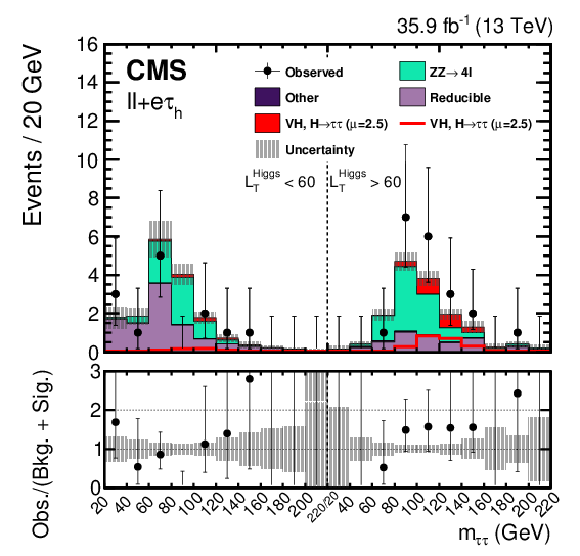
png pdf |
Figure 1-a:
The post-fit $ {m_{{\tau} {\tau}}} $ distribution used to extract the signal shown for $\ell \ell {\mathrm {e}} {{\tau} _\mathrm {h}} $. The uncertainties include both statistical and systematic components. The left half of the distribution is the low $ {L_{\text {T}}^{\text {Higgs}}} $ region, while the right half is the high $ {L_{\text {T}}^{\text {Higgs}}} $ region. The WH and ZH, $ {{\mathrm {H}} \to {\tau} {\tau}} $ signal processes are summed together and shown as VH, $ {{\mathrm {H}} \to {\tau} {\tau}} $ with a best fit $\mu = $ 2.5. VH, $ {{\mathrm {H}} \to {\tau} {\tau}} $ is shown both as a stacked filled histogram and an open overlaid histogram. The contribution from "Other'' includes events from triboson, $ {{\mathrm {t}\overline {\mathrm {t}}}} + {\mathrm {W}}$/$ {\mathrm {Z}} $, $ {{\mathrm {t}\overline {\mathrm {t}}}} {\mathrm {H}} $ production, and all production modes leading to $ {{\mathrm {H}} \to {\mathrm {W}} {\mathrm {W}}} $ and $ {{\mathrm {H}} \to {\mathrm {Z}} {\mathrm {Z}}} $ decays. The ZH, $ {{\mathrm {H}} \to {\tau} {\tau}} $ process contributes more than 99% of the total of VH, $ {{\mathrm {H}} \to {\tau} {\tau}} $. |
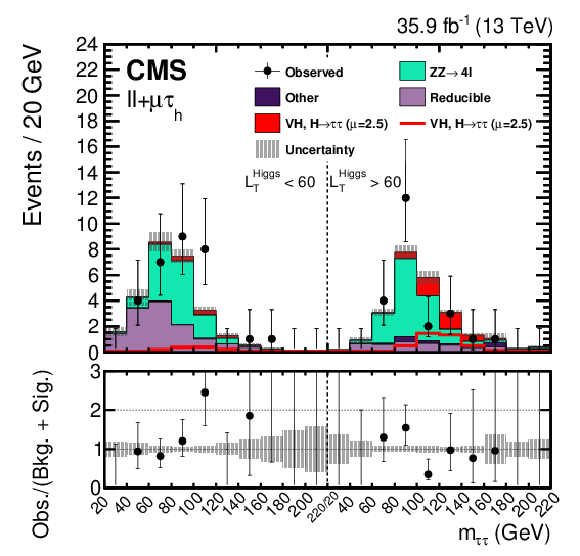
png pdf |
Figure 1-b:
The post-fit $ {m_{{\tau} {\tau}}} $ distribution used to extract the signal shown for $\ell \ell {{\mu}} {{\tau} _\mathrm {h}} $. The uncertainties include both statistical and systematic components. The left half of the distribution is the low $ {L_{\text {T}}^{\text {Higgs}}} $ region, while the right half is the high $ {L_{\text {T}}^{\text {Higgs}}} $ region. The WH and ZH, $ {{\mathrm {H}} \to {\tau} {\tau}} $ signal processes are summed together and shown as VH, $ {{\mathrm {H}} \to {\tau} {\tau}} $ with a best fit $\mu = $ 2.5. VH, $ {{\mathrm {H}} \to {\tau} {\tau}} $ is shown both as a stacked filled histogram and an open overlaid histogram. The contribution from "Other'' includes events from triboson, $ {{\mathrm {t}\overline {\mathrm {t}}}} + {\mathrm {W}}$/$ {\mathrm {Z}} $, $ {{\mathrm {t}\overline {\mathrm {t}}}} {\mathrm {H}} $ production, and all production modes leading to $ {{\mathrm {H}} \to {\mathrm {W}} {\mathrm {W}}} $ and $ {{\mathrm {H}} \to {\mathrm {Z}} {\mathrm {Z}}} $ decays. The ZH, $ {{\mathrm {H}} \to {\tau} {\tau}} $ process contributes more than 99% of the total of VH, $ {{\mathrm {H}} \to {\tau} {\tau}} $. |
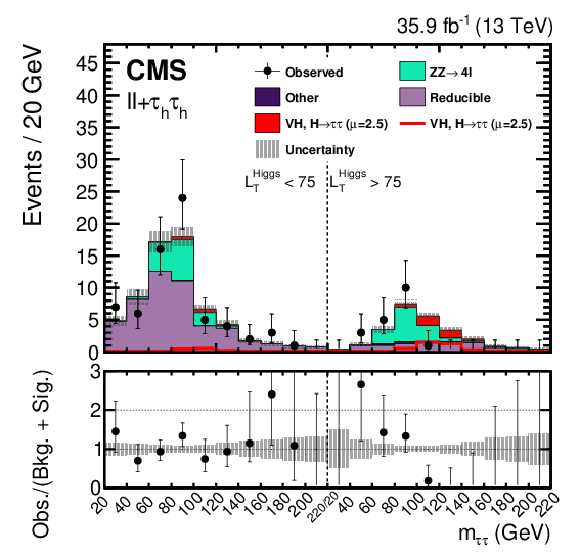
png pdf |
Figure 1-c:
The post-fit $ {m_{{\tau} {\tau}}} $ distribution used to extract the signal shown for $\ell \ell {{\tau} _\mathrm {h}} {{\tau} _\mathrm {h}} $. The uncertainties include both statistical and systematic components. The left half of the distribution is the low $ {L_{\text {T}}^{\text {Higgs}}} $ region, while the right half is the high $ {L_{\text {T}}^{\text {Higgs}}} $ region. The WH and ZH, $ {{\mathrm {H}} \to {\tau} {\tau}} $ signal processes are summed together and shown as VH, $ {{\mathrm {H}} \to {\tau} {\tau}} $ with a best fit $\mu = $ 2.5. VH, $ {{\mathrm {H}} \to {\tau} {\tau}} $ is shown both as a stacked filled histogram and an open overlaid histogram. The contribution from "Other'' includes events from triboson, $ {{\mathrm {t}\overline {\mathrm {t}}}} + {\mathrm {W}}$/$ {\mathrm {Z}} $, $ {{\mathrm {t}\overline {\mathrm {t}}}} {\mathrm {H}} $ production, and all production modes leading to $ {{\mathrm {H}} \to {\mathrm {W}} {\mathrm {W}}} $ and $ {{\mathrm {H}} \to {\mathrm {Z}} {\mathrm {Z}}} $ decays. The ZH, $ {{\mathrm {H}} \to {\tau} {\tau}} $ process contributes more than 99% of the total of VH, $ {{\mathrm {H}} \to {\tau} {\tau}} $. |
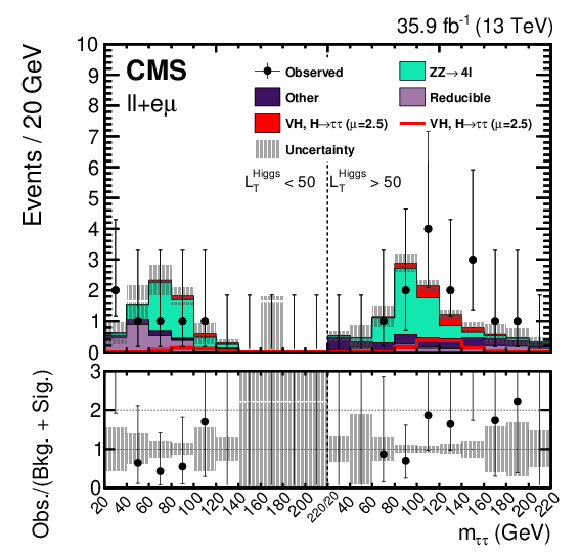
png pdf |
Figure 1-d:
The post-fit $ {m_{{\tau} {\tau}}} $ distribution used to extract the signal shown for $\ell \ell {\mathrm {e}} {{\mu}}$. The uncertainties include both statistical and systematic components. The left half of the distribution is the low $ {L_{\text {T}}^{\text {Higgs}}} $ region, while the right half is the high $ {L_{\text {T}}^{\text {Higgs}}} $ region. The WH and ZH, $ {{\mathrm {H}} \to {\tau} {\tau}} $ signal processes are summed together and shown as VH, $ {{\mathrm {H}} \to {\tau} {\tau}} $ with a best fit $\mu = $ 2.5. VH, $ {{\mathrm {H}} \to {\tau} {\tau}} $ is shown both as a stacked filled histogram and an open overlaid histogram. The contribution from "Other'' includes events from triboson, $ {{\mathrm {t}\overline {\mathrm {t}}}} + {\mathrm {W}}$/$ {\mathrm {Z}} $, $ {{\mathrm {t}\overline {\mathrm {t}}}} {\mathrm {H}} $ production, and all production modes leading to $ {{\mathrm {H}} \to {\mathrm {W}} {\mathrm {W}}} $ and $ {{\mathrm {H}} \to {\mathrm {Z}} {\mathrm {Z}}} $ decays. The ZH, $ {{\mathrm {H}} \to {\tau} {\tau}} $ process contributes more than 99% of the total of VH, $ {{\mathrm {H}} \to {\tau} {\tau}} $. |

png pdf |
Figure 2:
The post-fit $ {m_{{\tau} {\tau}}} $ distributions used to extract the signal, shown for all 8 ZH channels combined. The uncertainties include both statistical and systematic components. The left half of the distribution is the low $ {L_{\text {T}}^{\text {Higgs}}} $ region, while the right half corresponds to the high $ {L_{\text {T}}^{\text {Higgs}}} $ region. The definitions of the $ {L_{\text {T}}^{\text {Higgs}}} $ regions in this distribution are the same as those used in Fig. xxxxx and are final state dependent. The WH and ZH, $ {{\mathrm {H}} \to {\tau} {\tau}} $ signal processes are summed together and shown as VH, $ {{\mathrm {H}} \to {\tau} {\tau}} $ with a best fit $\mu = $ 2.5. VH, $ {{\mathrm {H}} \to {\tau} {\tau}} $ is shown both as a stacked filled histogram and an open overlaid histogram. The contribution from "Other'' includes events from triboson, $ {{\mathrm {t}\overline {\mathrm {t}}}} + {\mathrm {W}}$/$ {\mathrm {Z}} $, $ {{\mathrm {t}\overline {\mathrm {t}}}} {\mathrm {H}} $ production, and all production modes leading to $ {{\mathrm {H}} \to {\mathrm {W}} {\mathrm {W}}} $ and $ {{\mathrm {H}} \to {\mathrm {Z}} {\mathrm {Z}}} $ decays. In this distribution the ZH, $ {{\mathrm {H}} \to {\tau} {\tau}} $ process contributes more than 99% of the total of VH, $ {{\mathrm {H}} \to {\tau} {\tau}} $. |

png pdf |
Figure 3:
Post-fit mass distributions in the $ {\mathrm {e}} {{\mu}} {{\tau} _\mathrm {h}} $ (upper left), $ {{\mu}} {{\mu}} {{\tau} _\mathrm {h}} $ (upper right), $ {\mathrm {e}} {{\tau} _\mathrm {h}} {{\tau} _\mathrm {h}} $ (lower left), and $ {{\mu}} {{\tau} _\mathrm {h}} {{\tau} _\mathrm {h}} $ (lower right) final states. The uncertainties include both statistical and systematic components. The WH and ZH, $ {{\mathrm {H}} \to {\tau} {\tau}} $ signal processes are summed together and shown as VH, $ {{\mathrm {H}} \to {\tau} {\tau}} $ with a best fit $\mu = $ 2.5. VH, $ {{\mathrm {H}} \to {\tau} {\tau}} $ is shown both as a stacked filled histogram and an open overlaid histogram. The contribution from "Other'' includes events from triboson, $ {{\mathrm {t}\overline {\mathrm {t}}}} + {\mathrm {W}}$/$ {\mathrm {Z}} $, $ {{\mathrm {t}\overline {\mathrm {t}}}} {\mathrm {H}} $ production, and all production modes leading to $ {{\mathrm {H}} \to {\mathrm {W}} {\mathrm {W}}} $ and $ {{\mathrm {H}} \to {\mathrm {Z}} {\mathrm {Z}}} $ decays. In these distribution the $ {\mathrm {W}} {\mathrm {H}} $, $ {{\mathrm {H}} \to {\tau} {\tau}} $ processes contributes 91-93% of the total of VH, $ {{\mathrm {H}} \to {\tau} {\tau}} $. |
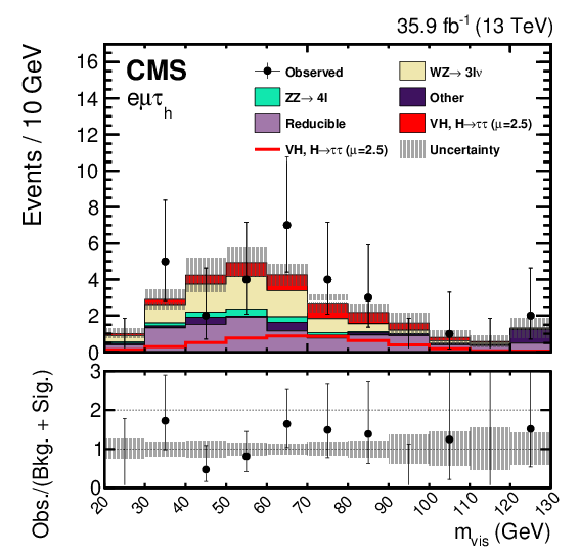
png pdf |
Figure 3-a:
Post-fit mass distribution in the $ {\mathrm {e}} {{\mu}} {{\tau} _\mathrm {h}} $. The uncertainties include both statistical and systematic components. The WH and ZH, $ {{\mathrm {H}} \to {\tau} {\tau}} $ signal processes are summed together and shown as VH, $ {{\mathrm {H}} \to {\tau} {\tau}} $ with a best fit $\mu = $ 2.5. VH, $ {{\mathrm {H}} \to {\tau} {\tau}} $ is shown both as a stacked filled histogram and an open overlaid histogram. The contribution from "Other'' includes events from triboson, $ {{\mathrm {t}\overline {\mathrm {t}}}} + {\mathrm {W}}$/$ {\mathrm {Z}} $, $ {{\mathrm {t}\overline {\mathrm {t}}}} {\mathrm {H}} $ production, and all production modes leading to $ {{\mathrm {H}} \to {\mathrm {W}} {\mathrm {W}}} $ and $ {{\mathrm {H}} \to {\mathrm {Z}} {\mathrm {Z}}} $ decays. The $ {\mathrm {W}} {\mathrm {H}} $, $ {{\mathrm {H}} \to {\tau} {\tau}} $ processes contributes 91-93% of the total of VH, $ {{\mathrm {H}} \to {\tau} {\tau}} $. |
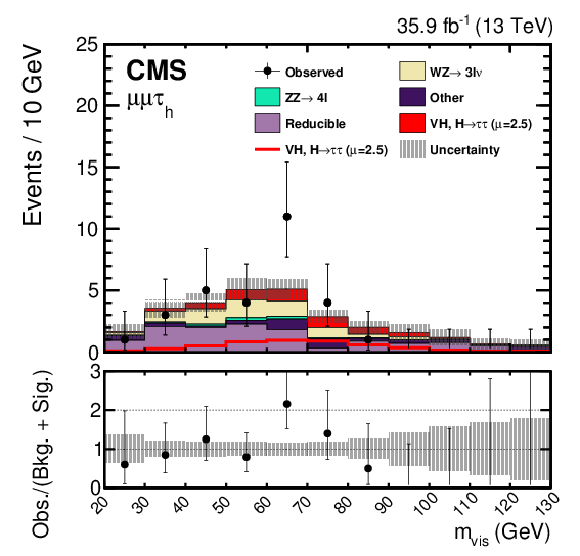
png pdf |
Figure 3-b:
Post-fit mass distribution in the $ {{\mu}} {{\mu}} {{\tau} _\mathrm {h}} $. The uncertainties include both statistical and systematic components. The WH and ZH, $ {{\mathrm {H}} \to {\tau} {\tau}} $ signal processes are summed together and shown as VH, $ {{\mathrm {H}} \to {\tau} {\tau}} $ with a best fit $\mu = $ 2.5. VH, $ {{\mathrm {H}} \to {\tau} {\tau}} $ is shown both as a stacked filled histogram and an open overlaid histogram. The contribution from "Other'' includes events from triboson, $ {{\mathrm {t}\overline {\mathrm {t}}}} + {\mathrm {W}}$/$ {\mathrm {Z}} $, $ {{\mathrm {t}\overline {\mathrm {t}}}} {\mathrm {H}} $ production, and all production modes leading to $ {{\mathrm {H}} \to {\mathrm {W}} {\mathrm {W}}} $ and $ {{\mathrm {H}} \to {\mathrm {Z}} {\mathrm {Z}}} $ decays. The $ {\mathrm {W}} {\mathrm {H}} $, $ {{\mathrm {H}} \to {\tau} {\tau}} $ processes contributes 91-93% of the total of VH, $ {{\mathrm {H}} \to {\tau} {\tau}} $. |
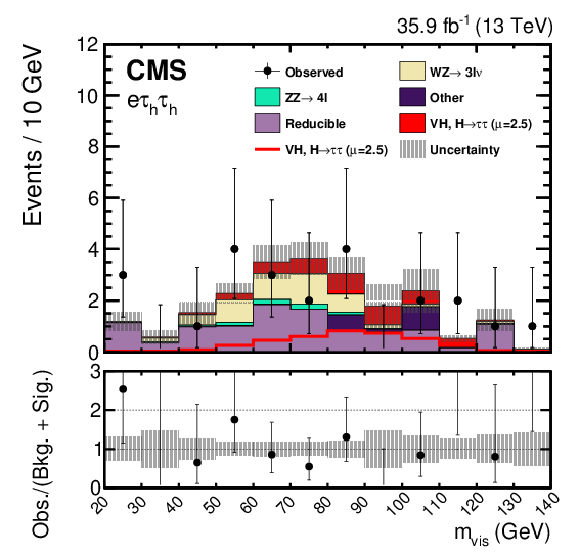
png pdf |
Figure 3-c:
Post-fit mass distribution in the $ {\mathrm {e}} {{\tau} _\mathrm {h}} {{\tau} _\mathrm {h}} $. The uncertainties include both statistical and systematic components. The WH and ZH, $ {{\mathrm {H}} \to {\tau} {\tau}} $ signal processes are summed together and shown as VH, $ {{\mathrm {H}} \to {\tau} {\tau}} $ with a best fit $\mu = $ 2.5. VH, $ {{\mathrm {H}} \to {\tau} {\tau}} $ is shown both as a stacked filled histogram and an open overlaid histogram. The contribution from "Other'' includes events from triboson, $ {{\mathrm {t}\overline {\mathrm {t}}}} + {\mathrm {W}}$/$ {\mathrm {Z}} $, $ {{\mathrm {t}\overline {\mathrm {t}}}} {\mathrm {H}} $ production, and all production modes leading to $ {{\mathrm {H}} \to {\mathrm {W}} {\mathrm {W}}} $ and $ {{\mathrm {H}} \to {\mathrm {Z}} {\mathrm {Z}}} $ decays. The $ {\mathrm {W}} {\mathrm {H}} $, $ {{\mathrm {H}} \to {\tau} {\tau}} $ processes contributes 91-93% of the total of VH, $ {{\mathrm {H}} \to {\tau} {\tau}} $. |
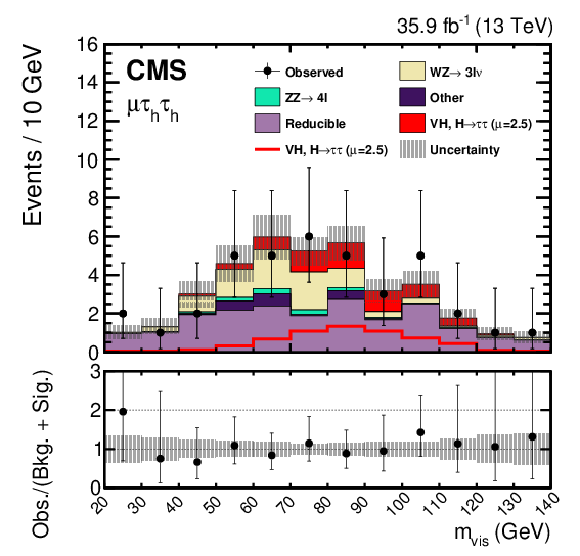
png pdf |
Figure 3-d:
Post-fit mass distribution in the $ {{\mu}} {{\tau} _\mathrm {h}} {{\tau} _\mathrm {h}} $. The uncertainties include both statistical and systematic components. The WH and ZH, $ {{\mathrm {H}} \to {\tau} {\tau}} $ signal processes are summed together and shown as VH, $ {{\mathrm {H}} \to {\tau} {\tau}} $ with a best fit $\mu = $ 2.5. VH, $ {{\mathrm {H}} \to {\tau} {\tau}} $ is shown both as a stacked filled histogram and an open overlaid histogram. The contribution from "Other'' includes events from triboson, $ {{\mathrm {t}\overline {\mathrm {t}}}} + {\mathrm {W}}$/$ {\mathrm {Z}} $, $ {{\mathrm {t}\overline {\mathrm {t}}}} {\mathrm {H}} $ production, and all production modes leading to $ {{\mathrm {H}} \to {\mathrm {W}} {\mathrm {W}}} $ and $ {{\mathrm {H}} \to {\mathrm {Z}} {\mathrm {Z}}} $ decays. The $ {\mathrm {W}} {\mathrm {H}} $, $ {{\mathrm {H}} \to {\tau} {\tau}} $ processes contributes 91-93% of the total of VH, $ {{\mathrm {H}} \to {\tau} {\tau}} $. |
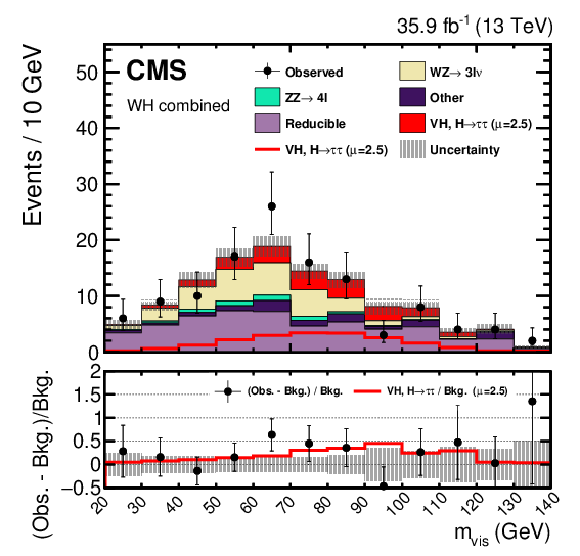
png pdf |
Figure 4:
Post-fit mass distributions of the four $ {\mathrm {W}} {\mathrm {H}} $ final states combined together. The uncertainties include both statistical and systematic components. The $ {\mathrm {W}} {\mathrm {H}} $ and ZH, $ {{\mathrm {H}} \to {\tau} {\tau}} $ signal processes are summed together and shown as VH, $ {{\mathrm {H}} \to {\tau} {\tau}} $ with a best fit $\mu = $ 2.5. VH, $ {{\mathrm {H}} \to {\tau} {\tau}} $ is shown both as a stacked filled histogram and an open overlaid histogram. The contribution from "Other'' includes events from triboson, $ {{\mathrm {t}\overline {\mathrm {t}}}} + {\mathrm {W}}$/$ {\mathrm {Z}} $, $ {{\mathrm {t}\overline {\mathrm {t}}}} {\mathrm {H}} $ production, and all production modes leading to $ {{\mathrm {H}} \to {\mathrm {W}} {\mathrm {W}}} $ and $ {{\mathrm {H}} \to {\mathrm {Z}} {\mathrm {Z}}} $ decays. In this distribution the $ {\mathrm {W}} {\mathrm {H}} $, $ {{\mathrm {H}} \to {\tau} {\tau}} $ process contributes 92% of the total of VH, $ {{\mathrm {H}} \to {\tau} {\tau}} $. |
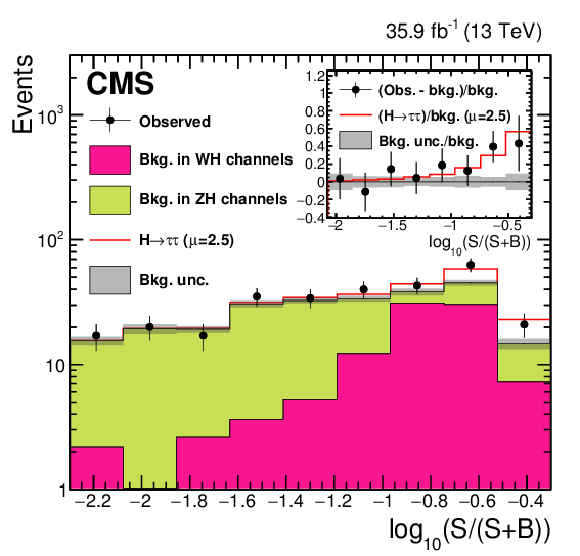
png pdf |
Figure 5:
Distribution of the decimal logarithm of the ratio between the expected signal and the sum of the expected signal and background. The signal, corresponding to the best fit value $\mu =2.5$, and expected background in each bin of the mass distributions used to extract the results, in all final states are combined. The background contributions are separated based on the analysis channel, $ {\mathrm {W}} {\mathrm {H}} $ or ZH. The inset shows the corresponding difference between the data and expected background distributions divided by the background expectation, as well as the signal expectation divided by the background expectation. |
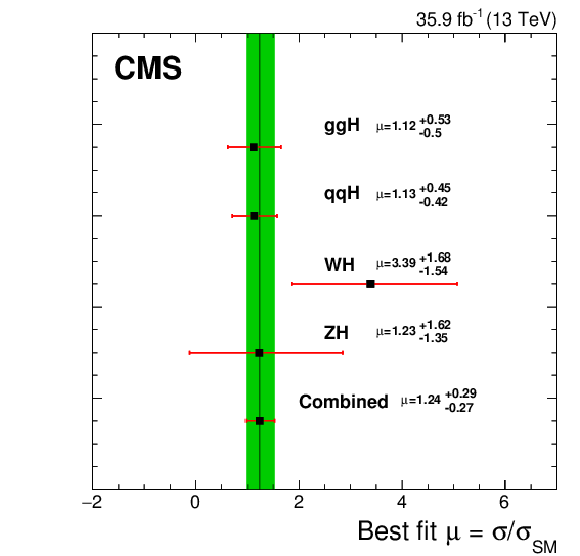
png pdf |
Figure 6:
Best fit signal strength per Higgs boson production process, for $ {m_{{\mathrm {H}}}} = 125$ GeV, using a combination of the $ {\mathrm {W}} {\mathrm {H}} $ and ZH targeted analysis detailed in this paper with the CMS analysis performed in the same data set for the same decay mode but targeting the gluon fusion and vector boson fusion production mechanisms [19]. The constraints from the combined global fit are used to extract each of the individual best fit signal strengths. The combined best fit signal strength is $\mu = 1.24 ^{+0.29} _{-0.27}$. |
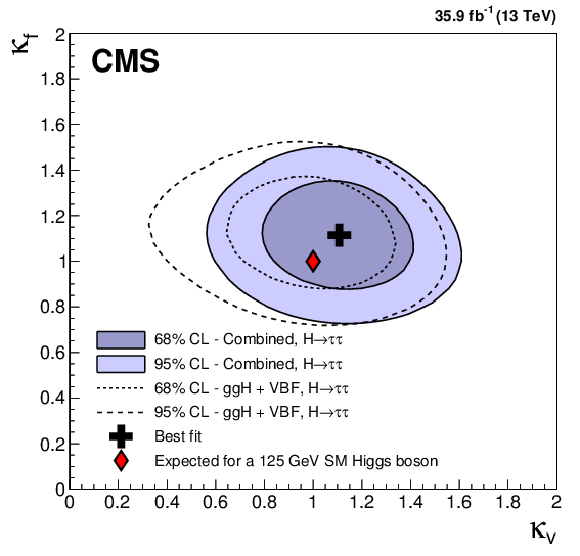
png pdf |
Figure 7:
Scans of the negative log-likelihood difference as a function of $\kappa _V$ and $\kappa _f$, for $ {m_{{\mathrm {H}}}} = $ 125 GeV. Contours corresponding to confidence levels ({\text {CL}}) of 68 and 95% are shown. All nuisance parameters are profiled for each point. The scan labeled as "Combined'' is a combination of the $ {\mathrm {W}} {\mathrm {H}} $ and ZH targeted analysis detailed in this paper with the CMS analysis performed in the same data set for the same decay mode but targeting the gluon fusion and vector boson fusion production mechanisms [19]. The results for the gluon fusion and vector boson fusion analysis are represented by the dashed lines and are labeled as "$ {\mathrm {g}} {\mathrm {g}} {\mathrm {H}} +\textrm {VBF}$''. For these scans, the included $ {{\mathrm {H}} \to {\mathrm {W}} {\mathrm {W}}} $ and $ {{\mathrm {H}} \to {\mathrm {Z}} {\mathrm {Z}}} $ processes are treated as signal. |
| Tables | |

png pdf |
Table 1:
Kinematic selection requirements for WH and ZH events. The trigger requirement is defined by a combination of trigger candidates with $ {p_{\mathrm {T}}} $ over a given threshold (in GeV), indicated inside parentheses. The $ | \eta |$ thresholds come from trigger and object reconstruction constraints. ZH events are selected with either a lower $ {p_{\mathrm {T}}} $ threshold double lepton trigger or a higher $ {p_{\mathrm {T}}} $ threshold single lepton trigger. |
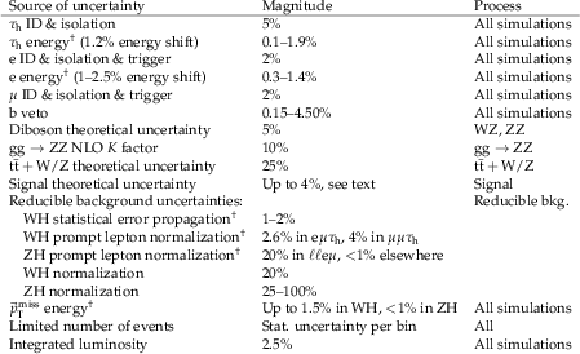
png pdf |
Table 2:
Sources of systematic uncertainty. The sign $\dagger $ marks the uncertainties that are both shape- and rate-based. Uncertainties that affect only the normalizations have no marker. For the shape and normalization uncertainties, the magnitude column lists the range of the associated change in normalization, which varies by process and final state. The last column specifies the processes affected by each source of uncertainty. |

png pdf |
Table 3:
Background and signal expectations for the ZH channels, together with the numbers of observed events, for the post-fit signal region distributions. The ZH final states are each grouped according to the Higgs boson decay products. The $\ell \ell $ notation covers both $ {\mathrm {Z}} \to {{\mu}} {{\mu}}$ and $ {\mathrm {Z}} \to {\mathrm {e}} {\mathrm {e}}$ events. The signal yields are the numbers of expected signal events for a Higgs boson with a mass $ {m_{{\mathrm {H}}}} = $ 125 GeV. The background uncertainty accounts for all sources of background uncertainty, systematic as well as statistical, after the global fit. The contribution from "Other'' includes events from triboson, $ {{\mathrm {t}\overline {\mathrm {t}}}} + {\mathrm {W}}$/$ {\mathrm {Z}} $, $ {{\mathrm {t}\overline {\mathrm {t}}}} {\mathrm {H}} $ production, and all production modes leading to $ {{\mathrm {H}} \to {\mathrm {W}} {\mathrm {W}}} $ and $ {{\mathrm {H}} \to {\mathrm {Z}} {\mathrm {Z}}} $ decays. |

png pdf |
Table 4:
Background and signal expectations for the WH channels, together with the numbers of observed events, for the post-fit signal region distributions. The signal yields are the numbers of expected signal events for a Higgs boson with a mass $ {m_{{\mathrm {H}}}} = $ 125 GeV. The background uncertainty accounts for all sources of background uncertainty, systematic as well as statistical, after the global fit. The contributions from triboson, $ {{\mathrm {t}\overline {\mathrm {t}}}} + {\mathrm {W}}$/$ {\mathrm {Z}} $, $ {{\mathrm {t}\overline {\mathrm {t}}}} {\mathrm {H}} $ production, and all production modes leading to $ {{\mathrm {H}} \to {\mathrm {W}} {\mathrm {W}}} $ and $ {{\mathrm {H}} \to {\mathrm {Z}} {\mathrm {Z}}} $ decays are included in the category labeled "Other''. |
| Summary |
|
A search is presented for the standard model (SM) Higgs boson in WH and ZH associated production processes, based on data collected in proton-proton collisions by the CMS detector in 2016 at a center-of-mass energy of 13 TeV. Event categories are defined by three-lepton final states targeting WH production, and four-lepton final states targeting ZH production. The best fit signal strength is $\mu = $ 2.5$ ^{+1.4} _{-1.3}$ (1.0$ ^{+1.1} _{-1.0}$ expected) for a significance of 2.3 standard deviations (1.0 expected). The results of this analysis are combined with those of the CMS analysis targeting gluon fusion and vector boson fusion production, also performed at a center-of-mass energy of 13 TeV, and constraints on the ${\mathrm{H}\to\tau\tau} $ decay rate are set. The best fit signal strength is $\mu = $ 1.24$ ^{+0.29} _{-0.27}$ (1.00$ ^{+0.24} _{-0.23}$ expected), and the observed significance is 5.5 standard deviations (4.8 expected) for a Higgs boson mass of 125 GeV. This combination further constrains the coupling of the Higgs boson to vector bosons, resulting in measured couplings that are consistent with SM predictions within one standard deviation, providing increased confidence that the Higgs boson couples to $\tau$ leptons through a Yukawa coupling as predicted in the SM. The combination allows for extraction of the signal strengths for the four leading Higgs boson production processes using exclusively ${\mathrm{H}\to\tau\tau} $ targeted final states, the results of which are largely consistent with the SM. The measurements of the Higgs boson production mechanisms using ${\mathrm{H}\to\tau\tau} $ decays are the best results to date for the WH and ZH associated production mechanisms using the ${\mathrm{H}\to\tau\tau} $ process. |
| References | ||||
| 1 | F. Englert and R. Brout | Broken symmetry and the mass of gauge vector mesons | PRL 13 (1964) 321 | |
| 2 | P. W. Higgs | Broken symmetries, massless particles and gauge fields | PL12 (1964) 132 | |
| 3 | P. W. Higgs | Broken symmetries and the masses of gauge bosons | PRL 13 (1964) 508 | |
| 4 | G. S. Guralnik, C. R. Hagen, and T. W. B. Kibble | Global conservation laws and massless particles | PRL 13 (1964) 585 | |
| 5 | P. W. Higgs | Spontaneous symmetry breakdown without massless bosons | PR145 (1966) 1156 | |
| 6 | T. W. B. Kibble | Symmetry breaking in non-abelian gauge theories | PR155 (1967) 1554 | |
| 7 | ATLAS Collaboration | Observation of a new particle in the search for the standard model Higgs boson with the ATLAS detector at the LHC | PLB 716 (2012) 1 | 1207.7214 |
| 8 | CMS Collaboration | Observation of a new boson at a mass of 125 GeV with the CMS experiment at the LHC | PLB 716 (2012) 30 | CMS-HIG-12-028 1207.7235 |
| 9 | CMS Collaboration | Observation of a new boson with mass near 125 GeV in pp collisions at $ \sqrt{s} = $ 7 and 8 TeV | JHEP 06 (2013) 081 | CMS-HIG-12-036 1303.4571 |
| 10 | ALEPH Collaboration | Observation of an excess in the search for the standard model Higgs boson at ALEPH | PLB 495 (2000) 1 | hep-ex/0011045 |
| 11 | DELPHI Collaboration | Final results from DELPHI on the searches for SM and MSSM neutral Higgs bosons | EPJC 32 (2004) 145 | hep-ex/0303013 |
| 12 | L3 Collaboration | Standard model Higgs boson with the L3 experiment at LEP | PLB 517 (2001) 319 | hep-ex/0107054 |
| 13 | OPAL Collaboration | Search for the standard model Higgs boson in e$ ^+ $e$ ^- $ collisions at $ \sqrt{s} = $ 192--209 GeV | PLB 499 (2001) 38 | hep-ex/0101014 |
| 14 | CDF Collaboration | Search for a low mass standard model Higgs boson in the $ \tau\tau $ decay channel in pp collisions at $ \sqrt{s} = $ 1.96 TeV | PRL 108 (2012) 181804 | 1201.4880 |
| 15 | D0 Collaboration | Search for the standard model Higgs boson in tau lepton pair final states | PLB 714 (2012) 237 | 1203.4443 |
| 16 | ATLAS Collaboration | Evidence for the Higgs-boson Yukawa coupling to tau leptons with the ATLAS detector | JHEP 04 (2015) 117 | 1501.04943 |
| 17 | ATLAS Collaboration | Search for the Standard Model Higgs boson produced in association with a vector boson and decaying into a tau pair in $ pp $ collisions at $ \sqrt{s} = $ 8 TeV with the ATLAS detector | PRD 93 (2016) 092005 | 1511.08352 |
| 18 | CMS Collaboration | Evidence for the 125 GeV Higgs boson decaying to a pair of $ \tau $ leptons | JHEP 05 (2014) 104 | CMS-HIG-13-004 1401.5041 |
| 19 | CMS Collaboration | Observation of the Higgs boson decay to a pair of $ \tau $ leptons with the CMS detector | PLB 779 (2018) 283 | CMS-HIG-16-043 1708.00373 |
| 20 | CMS Collaboration | The CMS trigger system | JINST 12 (2017) P01020 | CMS-TRG-12-001 1609.02366 |
| 21 | CMS Collaboration | The CMS experiment at the CERN LHC | JINST 3 (2008) S08004 | CMS-00-001 |
| 22 | P. Nason | A new method for combining NLO QCD with shower Monte Carlo algorithms | JHEP 11 (2004) 040 | hep-ph/0409146 |
| 23 | S. Frixione, P. Nason, and C. Oleari | Matching NLO QCD computations with parton shower simulations: the POWHEG method | JHEP 11 (2007) 070 | 0709.2092 |
| 24 | S. Alioli, P. Nason, C. Oleari, and E. Re | A general framework for implementing NLO calculations in shower Monte Carlo programs: the POWHEG BOX | JHEP 06 (2010) 043 | 1002.2581 |
| 25 | S. Alioli et al. | Jet pair production in POWHEG | JHEP 04 (2011) 081 | 1012.3380 |
| 26 | S. Alioli, P. Nason, C. Oleari, and E. Re | NLO Higgs boson production via gluon fusion matched with shower in POWHEG | JHEP 04 (2009) 002 | 0812.0578 |
| 27 | G. Luisoni, P. Nason, C. Oleari, and F. Tramontano | $ HW^{\pm}/HZ + 0 $ and 1 jet at NLO with the POWHEG BOX interfaced to GoSam and their merging within MiNLO | JHEP 10 (2013) 083 | 1306.2542 |
| 28 | R. D. Ball et al. | Unbiased global determination of parton distributions and their uncertainties at NNLO and at LO | NPB 855 (2012) 153 | 1107.2652 |
| 29 | D. de Florian, G. Ferrera, M. Grazzini, and D. Tommasini | Higgs boson production at the LHC: transverse momentum resummation effects in the $ \mathrm{H}\rightarrow \gamma\gamma $, $ \mathrm{H}\rightarrow {WW} \rightarrow l\nu l\nu $ and $ \mathrm{H}\rightarrow {ZZ}\rightarrow 4l $ decay modes | JHEP 06 (2012) 132 | 1203.6321 |
| 30 | M. Grazzini and H. Sargsyan | Heavy-quark mass effects in Higgs boson production at the LHC | JHEP 09 (2013) 129 | 1306.4581 |
| 31 | D. de Florian et al. | Handbook of LHC Higgs cross sections: 4. deciphering the nature of the Higgs sector | CERN-2017-002-M | 1610.07922 |
| 32 | A. Denner et al. | Standard model Higgs-boson branching ratios with uncertainties | EPJC 71 (2011) 1753 | 1107.5909 |
| 33 | NNPDF Collaboration | Impact of heavy quark masses on parton distributions and LHC phenomenology | NPB 849 (2011) 296 | 1101.1300 |
| 34 | J. M. Campbell and R. K. Ellis | MCFM for the Tevatron and the LHC | NPPS 205-206 (2010) 10 | 1007.3492 |
| 35 | R. Frederix and S. Frixione | Merging meets matching in MC@NLO | JHEP 12 (2012) 061 | 1209.6215 |
| 36 | J. Alwall et al. | Comparative study of various algorithms for the merging of parton showers and matrix elements in hadronic collisions | EPJC 53 (2008) 473 | 0706.2569 |
| 37 | T. Sjostrand et al. | An introduction to PYTHIA 8.2 | CPC 191 (2015) 159 | 1410.3012 |
| 38 | CMS Collaboration | Event generator tunes obtained from underlying event and multiparton scattering measurements | EPJC 76 (2016) 155 | CMS-GEN-14-001 1512.00815 |
| 39 | GEANT4 Collaboration | $ GEANT4--a $ simulation toolkit | NIMA 506 (2003) 250 | |
| 40 | CMS Collaboration | Particle-flow reconstruction and global event description with the CMS detector | JINST 12 (2017) P10003 | CMS-PRF-14-001 1706.04965 |
| 41 | M. Cacciari, G. P. Salam, and G. Soyez | The anti-$ {k_{\mathrm{T}}} $ jet clustering algorithm | JHEP 04 (2008) 063 | 0802.1189 |
| 42 | M. Cacciari, G. P. Salam, and G. Soyez | FastJet user manual | EPJC 72 (2012) 1896 | 1111.6097 |
| 43 | CMS Collaboration | Performance of electron reconstruction and selection with the CMS detector in proton-proton collisions at $ \sqrt{s}= $ 8 TeV | JINST 10 (2015) P06005 | CMS-EGM-13-001 1502.02701 |
| 44 | CMS Collaboration | Performance of the CMS muon detector and muon reconstruction with proton-proton collisions at $ \sqrt{s}= $ 13 TeV | JINST 13 (2018) P06015 | CMS-MUO-16-001 1804.04528 |
| 45 | M. Cacciari and G. P. Salam | Dispelling the $ N^{3} $ myth for the $ {k_{\mathrm{T}}} $ jet-finder | PLB 641 (2006) 57 | hep-ph/0512210 |
| 46 | CMS Collaboration | Identification of heavy-flavour jets with the CMS detector in pp collisions at 13 TeV | JINST 13 (2017) P05011 | CMS-BTV-16-002 1712.07158 |
| 47 | CMS Collaboration | Reconstruction and identification of $ \tau $ lepton decays to hadrons and $ \nu_\tau $ at CMS | JINST 11 (2016) P01019 | CMS-TAU-14-001 1510.07488 |
| 48 | CMS Collaboration | Performance of reconstruction and identification of tau leptons in their decays to hadrons and tau neutrino in LHC Run-2 | CMS-PAS-TAU-16-002 | CMS-PAS-TAU-16-002 |
| 49 | H. Voss, A. Hocker, J. Stelzer, and F. Tegenfeldt | TMVA, the toolkit for multivariate data analysis with ROOT | in XI Int. Workshop on Advanced Computing and Analysis Techniques in Physics Research 2007 | physics/0703039 |
| 50 | CMS Collaboration | Measurement of the inclusive W and Z production cross sections in pp collisions at $ \sqrt{s}= $ 7 TeV | JHEP 10 (2011) 132 | CMS-EWK-10-005 1107.4789 |
| 51 | L. Bianchini, J. Conway, E. K. Friis, and C. Veelken | Reconstruction of the Higgs mass in $ H \to \tau\tau $ events by dynamical likelihood techniques | J. Phys. Conf. Ser. 513 (2014) 022035 | |
| 52 | CMS Collaboration | Measurements of properties of the Higgs boson decaying into the four-lepton final state in pp collisions at $ \sqrt{s}= $ 13 TeV | JHEP 11 (2017) 047 | CMS-HIG-16-041 1706.09936 |
| 53 | CMS Collaboration | Measurement of the cross section for top quark pair production in association with a W or Z boson in proton-proton collisions at $ \sqrt{s} = $ 13 TeV | Submitted to JHEP | CMS-TOP-17-005 1711.02547 |
| 54 | CMS Collaboration | Performance of missing energy reconstruction in 13 TeV pp collision data using the CMS detector | CMS-PAS-JME-16-004 | CMS-PAS-JME-16-004 |
| 55 | CMS Collaboration | CMS luminosity measurements for the 2016 data taking period | CMS-PAS-LUM-17-001 | CMS-PAS-LUM-17-001 |
| 56 | K. Hamilton, P. Nason, E. Re, and G. Zanderighi | NNLOPS simulation of Higgs boson production | JHEP 10 (2013) 222 | 1309.0017 |

|
Compact Muon Solenoid LHC, CERN |

|

|

|

|

|

|